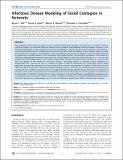| dc.contributor.author | Hill, Alison Lynn | |
| dc.contributor.author | Rand, David G. | |
| dc.contributor.author | Nowak, Martin A. | |
| dc.contributor.author | Christakis, Nicholas A. | |
| dc.date.accessioned | 2011-06-15T21:04:15Z | |
| dc.date.available | 2011-06-15T21:04:15Z | |
| dc.date.issued | 2010-11 | |
| dc.date.submitted | 2010-06 | |
| dc.identifier.issn | 1553-7358 | |
| dc.identifier.issn | 1553-734X | |
| dc.identifier.uri | http://hdl.handle.net/1721.1/64447 | |
| dc.description.abstract | Many behavioral phenomena have been found to spread interpersonally through social networks, in a manner similar to infectious diseases. An important difference between social contagion and traditional infectious diseases, however, is that behavioral phenomena can be acquired by non-social mechanisms as well as through social transmission. We introduce a novel theoretical framework for studying these phenomena (the SISa model) by adapting a classic disease model to include the possibility for ‘automatic’ (or ‘spontaneous’) non-social infection. We provide an example of the use of this framework by examining the spread of obesity in the Framingham Heart Study Network. The interaction assumptions of the model are validated using longitudinal network transmission data. We find that the current rate of becoming obese is 2 per year and increases by 0.5 percentage points for each obese social contact. The rate of recovering from obesity is 4 per year, and does not depend on the number of non-obese contacts. The model predicts a long-term obesity prevalence of approximately 42, and can be used to evaluate the effect of different interventions on steady-state obesity. Model predictions quantitatively reproduce the actual historical time course for the prevalence of obesity. We find that since the 1970s, the rate of recovery from obesity has remained relatively constant, while the rates of both spontaneous infection and transmission have steadily increased over time. This suggests that the obesity epidemic may be driven by increasing rates of becoming obese, both spontaneously and transmissively, rather than by decreasing rates of losing weight. A key feature of the SISa model is its ability to characterize the relative importance of social transmission by quantitatively comparing rates of spontaneous versus contagious infection. It provides a theoretical framework for studying the interpersonal spread of any state that may also arise spontaneously, such as emotions, behaviors, health states, ideas or diseases with reservoirs. | en_US |
| dc.description.sponsorship | National Institutes of Health (U.S.) (grant R01GM078986) | en_US |
| dc.description.sponsorship | National Science Foundation (U.S.) | en_US |
| dc.description.sponsorship | Bill & Melinda Gates Foundation | en_US |
| dc.description.sponsorship | Templeton Foundation | en_US |
| dc.description.sponsorship | National Institute on Aging (grant P01 AG031093) | en_US |
| dc.description.sponsorship | Framingham Heart Study (contract number N01-HC-25195) | en_US |
| dc.language.iso | en_US | |
| dc.publisher | Public Library of Science | en_US |
| dc.relation.isversionof | http://dx.doi.org/10.1371/journal.pcbi.1000968 | en_US |
| dc.rights | Creative Commons Attribution | en_US |
| dc.rights.uri | http://creativecommons.org/licenses/by/2.5/ | en_US |
| dc.source | PLoS | en_US |
| dc.title | Infectious Disease Modeling of Social Contagion in Networks | en_US |
| dc.type | Article | en_US |
| dc.identifier.citation | Hill Alison Lynn, et al. "Infectious Disease Modeling of Social Contagion in Networks." PLoS Comput Biol 6(11): e1000968. | en_US |
| dc.contributor.department | Whitaker College of Health Sciences and Technology | en_US |
| dc.contributor.approver | Hill, Alison Lynn | |
| dc.contributor.mitauthor | Hill, Alison Lynn | |
| dc.relation.journal | PloS Computational Biology | en_US |
| dc.eprint.version | Final published version | en_US |
| dc.type.uri | http://purl.org/eprint/type/JournalArticle | en_US |
| eprint.status | http://purl.org/eprint/status/PeerReviewed | en_US |
| dspace.orderedauthors | Hill, Alison L.; Rand, David G.; Nowak, Martin A.; Christakis, Nicholas A. | en |
| mit.license | PUBLISHER_CC | en_US |
| mit.metadata.status | Complete | |
